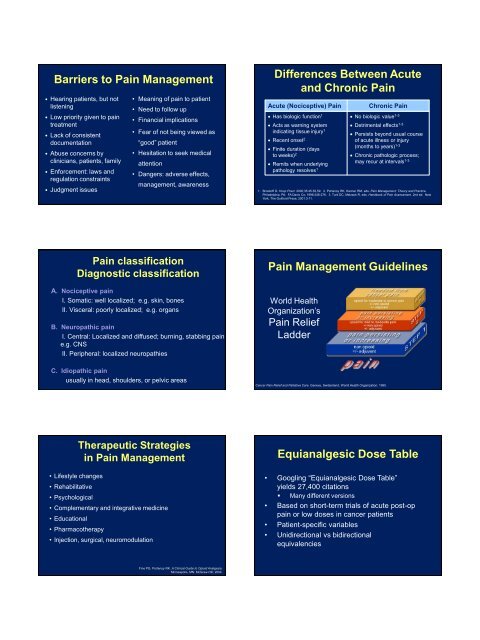Taking Control: Emerging Issues in Pain ... - Pharmacy Times
Taking Control: Emerging Issues in Pain ... - Pharmacy Times
Taking Control: Emerging Issues in Pain ... - Pharmacy Times
Create successful ePaper yourself
Turn your PDF publications into a flip-book with our unique Google optimized e-Paper software.
Barriers to Pa<strong>in</strong> Management<br />
• Hear<strong>in</strong>g patients, but not<br />
listen<strong>in</strong>g<br />
• Low priority given to pa<strong>in</strong><br />
treatment<br />
• Lack of consistent<br />
documentation<br />
• Abuse concerns by<br />
cl<strong>in</strong>icians, patients, family<br />
• Enforcement: laws and<br />
regulation constra<strong>in</strong>ts<br />
• Judgment issues<br />
• Mean<strong>in</strong>g of pa<strong>in</strong> to patient<br />
• Need to follow up<br />
• F<strong>in</strong>ancial implications<br />
• Fear of not be<strong>in</strong>g viewed as<br />
“good” patient<br />
• Hesitation to seek medical<br />
attention<br />
• Dangers: adverse effects,<br />
management, awareness<br />
Differences Between Acute<br />
and Chronic Pa<strong>in</strong><br />
Acute (Nociceptive) Pa<strong>in</strong><br />
Has biologic function 1<br />
Chronic Pa<strong>in</strong><br />
No biologic value 1-3<br />
Acts as warn<strong>in</strong>g system Detrimental effects 1-3<br />
<strong>in</strong>dicat<strong>in</strong>g tissue <strong>in</strong>jury 1 Persists beyond usual course<br />
Recent onset 2<br />
of acute illness or <strong>in</strong>jury<br />
F<strong>in</strong>ite duration (days<br />
(months to years) 1-3<br />
to weeks) 2<br />
Chronic pathologic process;<br />
Remits when underly<strong>in</strong>g<br />
may recur at <strong>in</strong>tervals 1-3<br />
pathology resolves 1<br />
1. Brookoff D. Hosp Pract. 2000;35:45-52,59. 2. Portenoy RK, Kanner RM, eds. Pa<strong>in</strong> Management: Theory and Practice.<br />
Philadelphia, PA: FA Davis Co; 1996:248-276. 3. Turk DC, Melzack R, eds. Handbook of Pa<strong>in</strong> Assessment. 2nd ed. New<br />
York, The Guilford Press; 2001:3-11.<br />
Pa<strong>in</strong> classification<br />
Diagnostic classification<br />
A. Nociceptive pa<strong>in</strong><br />
I. Somatic: well localized; e.g. sk<strong>in</strong>, bones<br />
II. Visceral: poorly localized; e.g. organs<br />
B. Neuropathic pa<strong>in</strong><br />
I. Central: Localized and diffused; burn<strong>in</strong>g, stabb<strong>in</strong>g pa<strong>in</strong><br />
e.g. CNS<br />
II. Peripheral: localized neuropathies<br />
Pa<strong>in</strong> Management Guidel<strong>in</strong>es<br />
World Health<br />
Organization’s<br />
Pa<strong>in</strong> Relief<br />
Ladder<br />
C. Idiopathic pa<strong>in</strong><br />
usually <strong>in</strong> head, shoulders, or pelvic areas<br />
Cancer Pa<strong>in</strong> Relief and Palliative Care. Geneva, Switzerland; World Health Organization; 1990.<br />
Therapeutic Strategies<br />
<strong>in</strong> Pa<strong>in</strong> Management<br />
Equianalgesic Dose Table<br />
• Lifestyle changes<br />
• Rehabilitative<br />
• Psychological<br />
• Complementary and <strong>in</strong>tegrative medic<strong>in</strong>e<br />
• Educational<br />
• Pharmacotherapy<br />
• Injection, surgical, neuromodulation<br />
• Googl<strong>in</strong>g “Equianalgesic Dose Table”<br />
yields 27,400 citations<br />
• Many different versions<br />
• Based on short-term trials of acute post-op<br />
pa<strong>in</strong> or low doses <strong>in</strong> cancer patients<br />
• Patient-specific variables<br />
• Unidirectional vs bidirectional<br />
equivalencies<br />
F<strong>in</strong>e PG, Portenoy RK. A Cl<strong>in</strong>ical Guide to Opioid Analgesia.<br />
M<strong>in</strong>neapolis, MN: McGraw-Hill; 2004.



